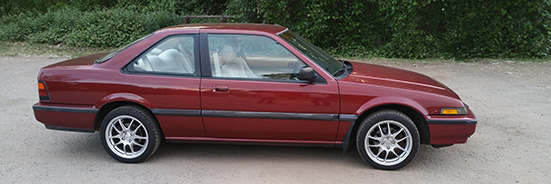
Originally Posted by
88Sleeper

My timing on my stock carb was set 2/3 of the way to the max limit of distributor advance with the stock carb. The stock setup pulls advance from manifold vacuum. BUT I had major vacuum leaks everywhere (based on my testing of the idle circuit components, etc.) With manifold vacuum on the weber, my distributor was actually RETARDED!! (the "middle marker" dot on the distributor bolt flange that tells you the middle ground between retarded and advanced was on the retarded side by a bit. This was at 1krpm idle with manifold vacuum, and the timing marks centered in the flywheel)
Due to the timing being retarded, when I would go WOT, my car wouldn't rev over 5.5k rpm without sucking fuel like a MOFO (I found I only got 24mpg at the pump when I checked after 200 mi).
It was also causing me huge hesitation issues when I'd open the throttle to put it into gear.. It didn't die necessarily, but I almost got nailed by a semi when I changed lanes and "punched it" only to sputter for about 3 seconds, thinking I was going to get my ass scrunched up nice.... I know it wasn't due to bogging down from too much fuel in the accelerator pump, since I have to slam it really fast to do that...
Solution -> I changed my vac advance to the port on the carb, and plugged the manifold vac source. once I did that, I reset the timing, and found that it landed on my timing marks perfectly at the same point as the stock carb did (I've got a wear mark on the flange, so I know I'm within .5 mm on the same spot)
The hesitation is almost completely gone now. Not all the way, since if I try hard enough, I can feel it, but for 80% of my driving, it is un-noticeable.
My concern -> When I "go" I am not sure if I have a knock or not. This is because there is now full-vacuum being applied to the vac advance when I accelerate, instead of the weak vac signal it was getting before. It pulls EXACTLY like it did before, with maybe a hint more of a fast "chugga-chuga" train sound when pulling on the upper gears. My gut feeling says the timing is a tad bit too early due to the much higher vac signal, but there's no knocking or pinging sound on this sucker!!? T.T
Spark Plug question -> I had Bosch Wx9 something plugs in there, and I put NGK FR6-something plugs in there now. My main question is whether or not cold plugs are better for the older motor? Sometimes when i shut the motor off, it diesels maybe once when I shut it down... I know that without the idle solenoid to plug the transition port on the stock carb, mine would diesel until I would cut it with the clutch & gear (great way of knowing when the solenoid is bad... not, lol) This weber doesn't have one, and I'd rather not switch to one if I have to replace the main idle jet... but I'm wondering if a hot plug is causing me the diesel? With the advanced timing, if it does diesel, it fires off once and only once, and then I get a noise like air getting shot back out through the carb (makes me think the piston gets thrown the other way when this happens).
Actual occurrence rate is maybe 1 in 5 shut-downs this happens, and it doesn't matter if I shut down at idle, or low-high rpm.
It started after I opened the throttle plates a bit more to get higher idle at start since my lights would cause idle bogging when I ran them, but it happens a tad less when I turned it down a hair.
Is it normal for the idle to hold steady, maybe +50 rpm when the engine is fully warmed up vs cold/still warming the water?
[other stuff]:
I can't hear that anymore, but I've been dealing with a plasticy rattle noise now. Last night I found one of the timing cover bolts was coming loose, and that helped some, but I almost feel like the spring on the timing belt tensioner is loose (I did that a month before the carb). I haven't confirmed yet, but I don't know if I should be worried if the spring comes loose, considering that the bearing is held in place by a bolt? I checked the belt for tension when I found teh loose plastic cover bolt, and it's still nice and snug (maybe 1-2mm of play) on the tensioner side, & the front side of the belt (left side of camshaft gear) is solidly tight (no budge).
Thank you and lostforawhile in getting this swap done! I really love the weber, but to be honest, I'm seeing performance being equal, maybe a hair better in the low-end with the 38, but I traded 32/40 mpg average for what I'm thinking will come out to 28/?? average now..
)







 Reply With Quote
Reply With Quote




Bookmarks